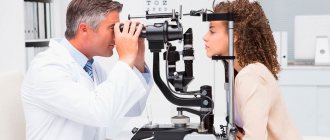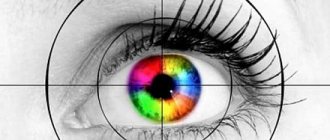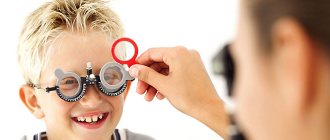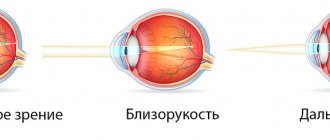Decreased vision with sub-zero readings indicates the development of myopia, that is, myopia. This pathology is characterized by impaired visual perception of objects located at a long distance. But a person sees nearby objects quite clearly. The retina, which contains light receptors, is a continuation of the optic nerve. With normal vision, an image is formed on it. If it decreases in a negative direction, a person develops myopia - a defect in which the image is formed in front of the retina. The condition should be corrected by an ophthalmologist.
The principle of the eye and features of myopia
The main task of the human optical system is the correct refraction and focusing of rays (refraction). In this case, the retina, the shell that collects light rays and forms a preliminary image, is directly responsible for visual acuity. To obtain a high-quality image, it is necessary that the rays are concentrated precisely in the central zone of the retina - the macula.
With negative visual perception, the image is created not on the retina, but in front of it, which is considered a refractive error. This disease is called myopia, or myopia. The anatomical prerequisite for the anomaly is a change in the shape of the eyeball - with myopia it is increased in length, so the retina is further than the focusing plane.
How does a person with such vision see?
Indicators of minus vision with a numerical value from 1 to 3 refer to low degree myopia. In general, myopia is characterized by poor distance vision - objects look unclear, their contours are blurred, a person cannot detail the picture and see small nuances. A mild degree of myopia is characterized by slight blurriness, while near vision remains good.
A person with such myopia without glasses may well:
- read and write;
- work on computer;
- perform minor manual work;
- navigate in space.
The person does not experience any particular difficulties in everyday life. But if a visual task arises “at a distance,” you have to wear glasses. With myopia, without optical aids, it is difficult for the patient to distinguish the numbers of approaching public transport, distant price tags in a store, look at the TV screen and recognize the faces of passers-by.
REFERENCE: Myopia can be accompanied by somatic symptoms - headaches, chronic fatigue and painful sensations in the eyes.
Some patients diagnosed with “vision -3” are interested in what percentage this is. It is immediately necessary to clarify that ophthalmologists do not measure sharpness as a percentage, but focus exclusively on diopters. But among the common people it was the concept of percentage that took root. It can only be determined conditionally if we take one row of Sivtsev’s table as 10%. At minus 3 diopters, a person sees on average 3 lines, so such vision can be designated as 30 percent.
Myopia symptoms
The main symptoms of the initial stage of the disease are:
- rapid eye fatigue when reading or sitting at a computer,
- pain and discomfort in the eyes,
- headache,
- increased tearfulness,
- decreased twilight vision,
- the appearance of circles or goosebumps before the eyes,
- dry mucous membranes,
- conjunctivitis.
To determine the severity of myopia, a table with letter symbols of different sizes is used. If the diagnosis is confirmed, ophthalmologists prescribe patients exercises to strengthen the eye muscles and contact lenses or glasses.
It is worth noting that wearing optics slows down the progression of the disease, but does not improve visual acuity. Drug therapy includes the use of drops and medication to restore blood circulation in the visual organs, but is advisable only at the initial stage of the disease.
Poor vision due to myopia, indicating a high degree of myopia, can cause the development of irreversible consequences associated with the functioning of the visual apparatus, including complete blindness.
About the causes of myopia
The fundamental factor in the development of myopia is hereditary weakness of accommodation or a genetically determined abnormal shape of the eyeball. Failure to comply with the rules of visual hygiene is no less important:
- insufficient lighting in the room;
- improperly organized workplace of a schoolchild or adult;
- incorrect posture;
- prolonged and excessive visual stress caused by working at the computer, reading, writing;
- abuse of gadgets and computer games.
Myopia is often caused by injuries, hormonal imbalances, problems with the lens and cornea, and general inflammatory and infectious diseases that disrupt the metabolic processes of the eyeball.
Correction and treatment
Mild myopia is not so much treated as corrected. Correction of myopia allows you to lead a full life and have excellent spatial orientation. And the most important thing is to avoid the progression of the disease and its transition to the next stage.
ARTICLES ON THE TOPIC:
- Complex treatment of myopia in children: hardware and drug methods, not...
- Test for color blindness: 27 Rabkin tables for checking color perception and identifying pathology
- What does vision minus 6 mean and how does a person with high myopia see?
Traditionally, optical devices such as glasses and soft contact lenses are used for correction.
Each of the two types of optics has its own advantages and disadvantages:
- lenses are expensive, require special care, but give greater freedom of action;
- Glasses are a budget option; you can use them for several years, but you don’t have the same freedom as lenses.
A prescription for glasses and lenses is written by a doctor after diagnosis and selection of the most comfortable optics in a clinic setting.
How to restore good vision with therapeutic methods:
taking fortified complexes to improve metabolic processes and instilling drops to relieve tension in the eye muscles;- special hardware techniques and simulators - designed to improve the condition of the retina, normalize accommodation and stabilize muscle tone;
- laser operations (PRK, LASEK, LASIK) - allow you to completely get rid of myopia and give up glasses.
Surgeries are indicated for malignant myopia, when visual acuity rapidly deteriorates and conservative methods are ineffective.
REFERENCE: Vitamins A, C, group B, as well as the minerals iron, iodine, selenium, chromium, manganese and calcium will help support the functioning of the visual system.
Diagnostics
The exact degree of myopia is determined after reviewing the results of the following studies:
- vision testing using special tables;
- studying the fundus of the eye, feeding blood vessels and the refractive power of the visual apparatus;
- ultrasound analysis (the thickness of the cornea and the length of the eye are determined);
| As a rule, the listed methods are quite sufficient to diagnose the disease and its stages, on the day of treatment, as well as to prescribe corrective actions and treatment. |
Anatomical myopia
The pathology is predetermined by the altered shape, in most cases, elongated along the eyeball. What is the incorrect convergence of rays at a point to the surface of the retina, despite the attempts of the lens to influence correct focusing. It is hereditary in nature and develops from a young age.
For patients with this form of pathology, wearing glasses is mandatory, since failure to wear them will lead to even greater muscle tension and elongation of the body of the eye. In particularly advanced cases, surgical intervention is used for treatment.
Accommodative myopia
This type of myopia is caused by atrophy of the eye muscle, which, through its contraction, changes the shape of the lens. If it is weakened, it cannot compress the natural lens properly, and as a result, the focal point of light is located in front of the retinal surface.
It is more susceptible to children whose development of the muscular system of the eye occurs with a certain lag. Or atrophy is caused by overstrain of the visual apparatus, under the influence of external factors, such as reading in the dark, excessive passion for gadgets and the computer.
| In case of accommodative myopia, wearing glasses is strictly contraindicated. Their use will only aggravate the situation and will contribute to further muscle atrophy. |
This type of pathology is treated with regular eye exercises, proper diet, rest and relaxation of the visual apparatus.
The most common questions
Although myopia of minus 3 diopters is considered weak, it is quite difficult for the patient to manage without corrective optics. Office workers who are primarily involved in close-range activities do not experience any particular discomfort from myopia. But representatives of active professions suffer more - they are forced to constantly carry glasses with them or worry about buying lenses. Below are answers to the most common questions about myopia.
How is pregnancy going? Mild myopia does not affect the course of pregnancy and does not pose a threat to the expectant mother and child.
Is it possible to give birth naturally? Minus vision of 3 diopters does not cause retinal detachment during natural delivery and is not an indication for cesarean section.
Is it possible to drive a car? It is possible, but only if the driver uses glasses or contact lenses while driving.
Do people with such vision get recruited into the army? With visual acuity of up to minus 6 diopters, the young man is considered fit for military service. But with some restrictions on physical activity. If myopia is complicated by severe astigmatism, the commission may consider the issue of unsuitability for military service.
Determination of visual acuity
A patient who comes for an ophthalmological examination is seated at a distance of 5 meters from the test table. Next, they begin to carry out diagnostics, first for the right eye, and then for the left. First, the doctor asks to name the signs placed in line 10. Provided they are correctly determined, the patient’s vision is considered 100% or equal to 1.0, in other words, normal. If the patient has difficulty identifying the signs of the 10th line, further examination continues from the top line, gradually moving lower. This continues until a line is identified whose signs the patient is not able to recognize from a five-meter distance.









